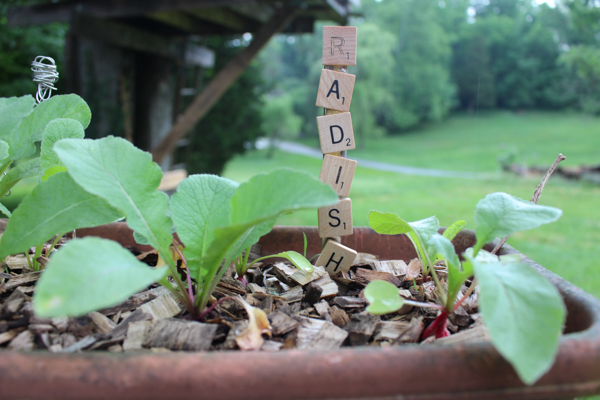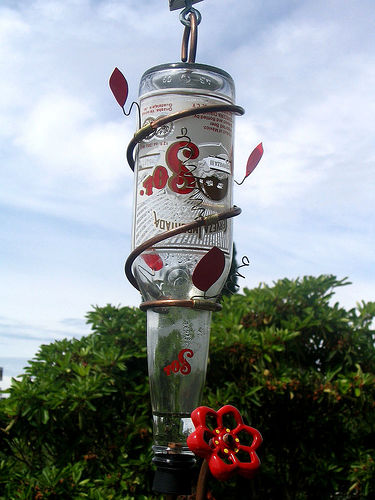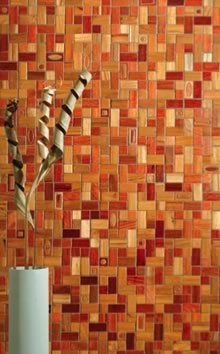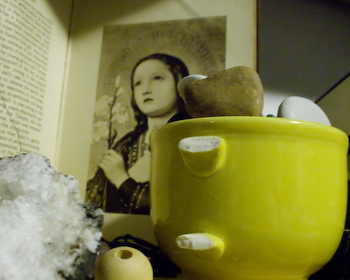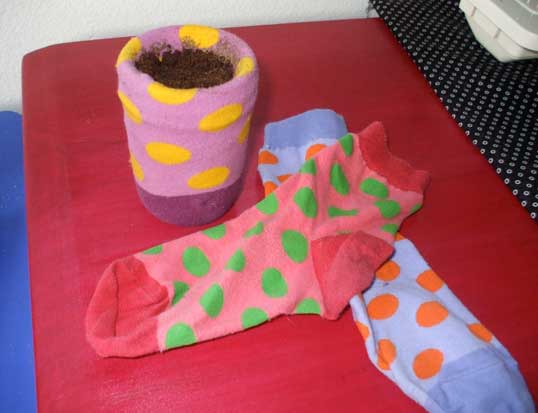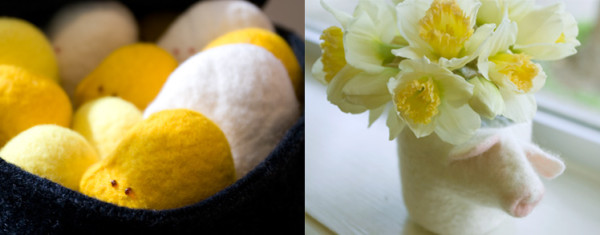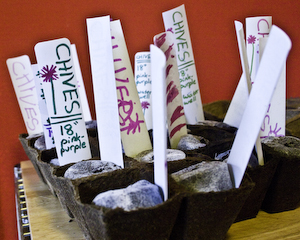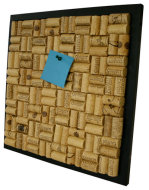If you do not use plant markers, you will regret it.
Yes, I know you’re SOOOOO excited to plant that watermelon seed that you don’t think you’ll ever forget exactly where and what it is. But you will. I give you until mid-June before you’re looking at it and thinking to yourself, “Squash? Gourd? Watermelon? Bindweed?!?”
There are enough surprises in gardening. The location of your plants shouldn’t be one of them.
Instead of dealing with an entire summer full of surprises, just make some of these awesome plant markers. You’ll know where everything is, and your garden will be even more chock-full of character than it already is. Check out the tutorials below and get inspired!
1. Butter knife and Scrabble tile plant marker. The butter knife part of this plant marker worked a peach, but the Scrabble tiles needed to be replaced this year. Fortunately, they’re just wood, so I tossed them into the mulch pile, but I bet that a good coat of clear sealant would allow them to stand up better to the weather.
2. Decoupaged metal spoons. When you run out of Scrabble tiles, turn to pretty paper and thrifted spoons and make a whole other set of plant markers.
3. Paint stirrer plant markers. Liberating paint stirrers from the hardware store for this project is NOT upcycling (and don’t take those paint chips, either!), but after you’ve used a paint stirrer for its designated purpose, it’s actually perfectly set up for this project, complete with the background color!
https://www.instagram.com/p/BEuVBAopZqD/
4. Plastic animals. I love the idea of upcycling my kids’ old plastic animals into plant markers. It makes me feel like less of a hoarder for not wanting to give them away yet!
5. Wine bottle corks. You’re drinking wine for a good cause when you upcycle the corks into these plant markers. Pro tip: you can wood burn onto a cork, and it’ll last longer than even an oil marker.
6. Wooden plant flags. If you want to put a little more work into your plant markers but still use entirely natural and/or upcycled materials, check out these wooden plant flags. They look great and require nothing but wood scraps, raffia, and markers.
7. Wire-wrapped found object plant markers. These are a lot of fun, especially if you’re a jeweler or scrapbooker. Epoxy glue and lots of teeny-tiny found object embellishments make each plant marker a unique work of art!
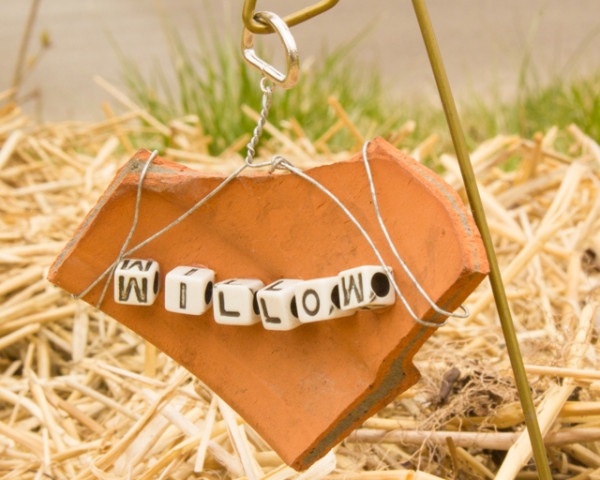
8. Beaded garden markers. If it’s mostly piles of beads that you have in your stash, try making these beaded plant markers, instead.
9. Flattened and stamped spoons. These spoons end up looking delicate, but there’s a lot of fun hammering that goes into making them. It’s a good way to get out your aggression!
10. Mason jar lid plant markers. When Mason jar lids get dings or dents they’re no longer suitable for canning, but there are still a ton of useful ways to upcycle them, including these lovely plant markers.
11. Peeled stick garden markers. This tutorial also shows you how to paint your peeled stick garden marker to look like a gnome, because you KNOW you need that!
12. Plant saucer and copper wire. Old terra cotta plant saucers and copper wire from the hardware store make surprisingly sophisticated plant markers.
13. Plant flag. These cute and upcycled plant flags aren’t suitable for outdoor garden markers, but they’re perfect for including with a gifted plant, or even for an indoor potted plant.
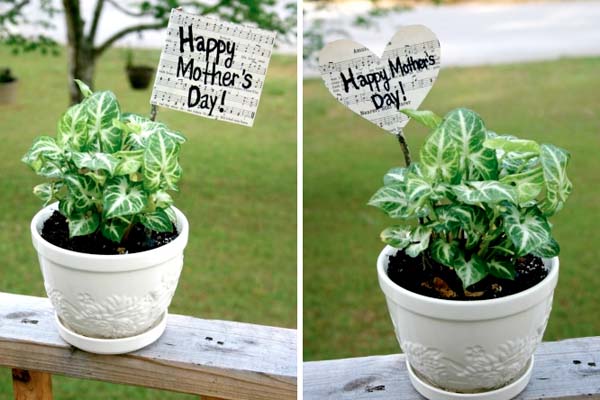
14. Clothespin plant markers. I love the idea of clothespins, but washi tape is NOT going to hold up. Instead, I think that you should wood burn them!
15. Painted shoe stretchers. This is proof that you can figure out a great way to upcycle anything–including vintage wooden shoe stretchers!
16. Placemat garden flag. Upcycle a placemat into a flag that marks off a certain part of your garden.
17. Stamped polymer clay. These markers won’t weather, but they’re on the delicate side, so best suited for potted plants. They work with any kind of polymer clay, so save up the scraps from your other polymer clay projects and use them up for this.
18. Wine bottle capsules. This is such a smart idea. Those wine bottle capsules are hard to upcycle!
19. Painted stones. This is a terrifically kid-friendly plant marker. Small kids can do all the background painting for you, and big kids can do everything from the decoration to figuring out how to spell the Latin name for the sunflower!

20. Painted stone on a stick Worried that your painted stone will get lost at ground level? Give it a little elevation!
21. Wooden spoons. Hit up any yard sale or thrift shop for bunches of wooden spoons that would be perfect for this project.
https://www.instagram.com/p/Bie8F50FcwI/
22. Stamped can lid. While you’re thrifting wooden spoons, also grab a handful of forks. They’re exactly what you need to mount these upcycled can lid plant markers.
23. Etched aluminum cans. These aren’t as sturdy as the stamped can lids, but they’re easier to etch and you can make them quite decorative.
24. Wired aluminum can flags. I really like the look of these plant flags, also made from aluminum cans.
25. Fence stake plant markers. You can upcycle just about anything into a plant marker if you’ve got a moveable alphabet to play with. These fence stake plant markers are perfect for marking out a larger area of plantings.
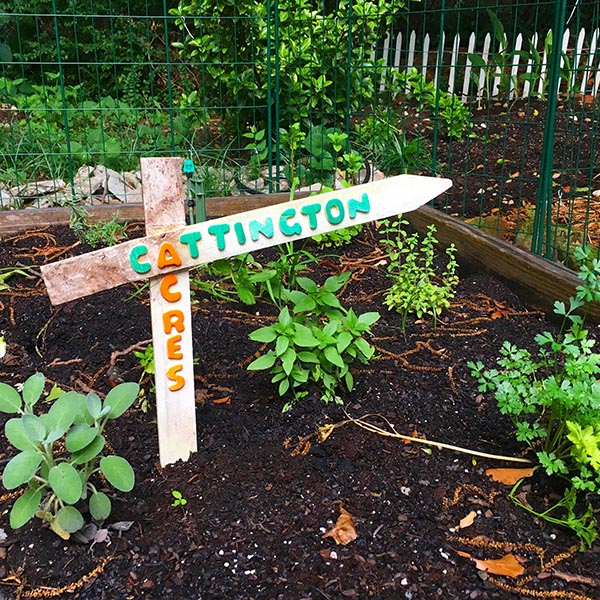
26. Bottle cap garden art. Sometimes you don’t need to know the names of what you planted, just that there are plants there. In that case, don’t bother with labels, and instead make some art!
27. Broken terra cotta pot markers. I think that these look super-duper cute, like little flowerpots partially buried in the garden. I have a couple of pots on which the bottoms are broken off, and I like to place those completely around a little plant for a similar adorably organized look.
https://www.instagram.com/p/BnD-byylpCb/
28. Fabric flags. This would be an easy way to color code your garden–one fabric pattern for herbs, one for veggies, one for flowers, etc.
29. Stamped metal washers. I really like the low profile of these handy labels. After all, why detract anything from the beautiful visual of your flowers in bloom?
30. Stepping stones. Wouldn’t it be cute to have a garden path that also marked out where the plants were?
Do you have a tried-and-true way to make plant markers? Share it with me in the Comments below!

